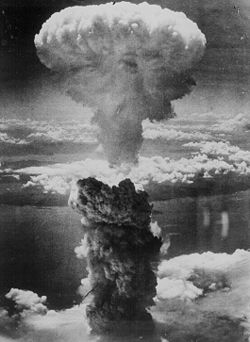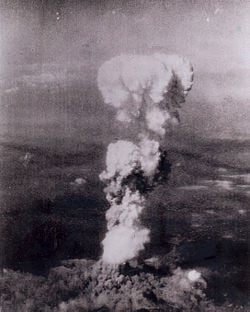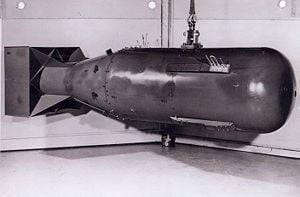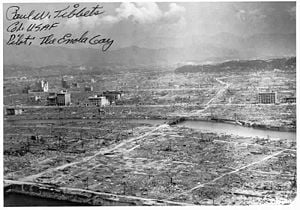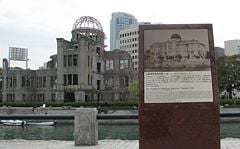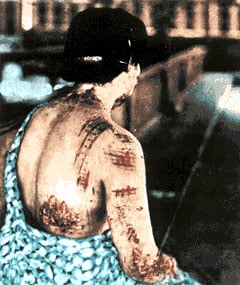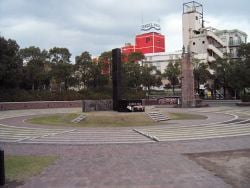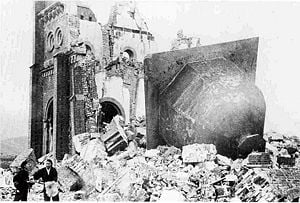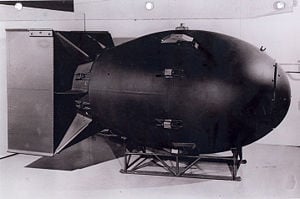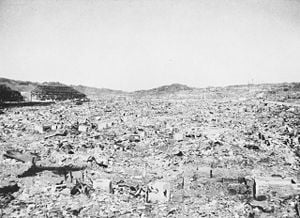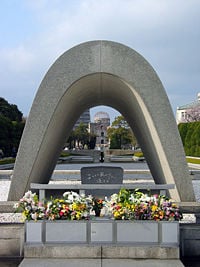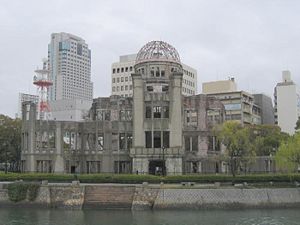Bombing of Hiroshima and Nagasaki
On the morning of August 6, 1945, the United States Army Air Forces dropped the nuclear weapon "Little Boy" on the city of Hiroshima, Japan. Three days later, the "Fat Man" bomb was detonated over Nagasaki.
In estimating the death toll from the attacks, there are several factors that make it difficult to arrive at reliable figures: inadequacies in the records given the confusion of the times, the many victims who died months or years after the bombing as a result of radiation exposure, and not least, the pressure to either exaggerate or minimize the numbers, depending upon political agenda. That said, it is estimated that by December 1945, as many as 140,000 had died in Hiroshima by the bomb and its associated effects.[1][2] In Nagasaki, roughly 74,000 people died of the bomb and its aftereffects.
In both cities, most of the casualties were civilians. The intentional killing of civilians by the Allies of World War II—who claimed that their cause was just—raised moral questions about the just course of the war, as had the Bombing of Dresden, Germany.
The role of the bombings in Japan’s surrender, as well as the effects and justification of them, has been subject to much debate. In the United States, the prevailing view is that the bombings ended the war months sooner than would otherwise have been the case, saving many lives that would have been lost on both sides if the planned invasion of Japan had taken place.[3] In Japan, the general public tends to think that the bombings were needless as the preparation for the surrender was in progress in Tokyo. Many people determined that the Hiroshima and Nagasaki bombings should remain the first and last hostile use of atomic weapons. During the Cold War, although the competing superpowers stockpiled huge nuclear arsenals, only testing took place.
The dropping of “Little Boy” was a defining moment of the twentieth century. All subsequent human history is lived under the shadow of the mushroom cloud and in the knowledge that humanity can destroy the planet and all who inhabit the earth.
Prelude to the bombings

The United States, with assistance from the United Kingdom and Canada, designed and built the first atomic bombs under what was called the Manhattan Project. The project was instigated by European refugee scientists (including Albert Einstein) and American scientists who feared that Nazi Germany would also be conducting a full-scale bomb development program (this was later discovered to be incorrect). The project itself eventually employed over 130,000 people at its peak at over thirty institutions spread over the United States, and cost a total of nearly $2 billion U.S. dollars, making it one of the most enormous research and development programs of all time.
The first nuclear device, called "Gadget," was detonated during the "Trinity" test near Alamogordo, New Mexico on July 16, 1945. The Hiroshima and Nagasaki bombs were the second and third to be detonated and the only ones ever employed so far in history as weapons of mass destruction.
During World War II, both the Allies and Axis powers had previously pursued policies of strategic bombing and the targeting of civilian infrastructure related to the war, such as armaments factories. In numerous cases these had caused huge numbers of civilian casualties and were (or came to be) controversial. In Germany, the Allied Bombing of Dresden resulted in roughly 30,000 deaths, while the Bombing of Tokyo may have killed as many as 100,000 people. By August, about 60 Japanese cities had been destroyed through a massive aerial campaign, including massive firebombing raids on the cities of Tokyo and Kobe.
Over three and a half years of direct U.S. involvement in World War II, approximately 400,000 American lives had been lost, roughly half of them incurred in the war against Japan. In the months prior to the bombings, the Battle of Okinawa resulted in an estimated 50,000 to 150,000 civilian deaths, 100,000 to 125,000 Japanese or Okinawan military or conscript deaths and over 72,000 American casualties. An invasion of Japan was expected to result in casualties many times greater than in Okinawa.
U.S. President Harry S. Truman, who was unaware of the Manhattan Project until Franklin Delano Roosevelt's death, made the decision to drop the atomic bombs on Japan. His stated intention in ordering the bombings was to bring about a quick resolution of the war by inflicting destruction, and instilling fear of further destruction, that was sufficient to cause Japan to surrender. On July 26, Truman and other allied leaders issued The Potsdam Declaration outlining terms of surrender for Japan:
...The might that now converges on Japan is immeasurably greater than that which, when applied to the resisting Nazis, necessarily laid waste to the lands, the industry and the method of life of the whole German people. The full application of our military power, backed by our resolve, will mean the inevitable and complete destruction of the Japanese armed forces and just as inevitably the utter devastation of the Japanese homeland... ...We call upon the government of Japan to proclaim now the unconditional surrender of all Japanese armed forces, and to provide proper and adequate assurances of their good faith in such action. The alternative for Japan is prompt and utter destruction.
The next day, Japanese papers reported that the declaration, the text of which had been broadcast and dropped on leaflets into Japan, had been rejected. The atomic bomb was still a highly guarded secret and not mentioned in the declaration.
Choice of targets
The Target Committee at Los Alamos on May 10–11, 1945, recommended Kyoto, Hiroshima, Yokohama, and the arsenal at Kokura as possible targets. The committee rejected the use of the weapon against a strictly military objective because of the chance of missing a small target not surrounded by a larger urban area. The psychological effects on Japan were of great importance to the committee members. They also agreed that the initial use of the weapon should be sufficiently spectacular for its importance to be internationally recognized.
The committee felt Kyoto, as an intellectual center of Japan, had a population "better able to appreciate the significance of the weapon." Hiroshima was described as "an important army depot and port of embarkation in the middle of an urban industrial area. It is a good radar target and it is such a size that a large part of the city could be extensively damaged. There are adjacent hills which are likely to produce a focusing effect which would considerably increase the blast damage. Due to rivers it is not a good incendiary target."[4]
Secretary of War Henry L. Stimson struck Kyoto from the list because of its cultural significance, over the objections of General Leslie Groves, head of the Manhattan Project. According to Professor Edwin O. Reischauer, Stimson "had known and admired Kyoto ever since his honeymoon there several decades earlier."[5]
On July 25, Nagasaki was put on the target list in place of Kyoto.
Hiroshima
Hiroshima during World War II
Hiroshima was a city of considerable industrial and military significance. Military camps were located nearby, such as the headquarters of the Fifth Division and Field Marshal Shunroku Hata's 2nd General Army Headquarters, which commanded the defense of all of southern Japan. Hiroshima was a minor supply and logistics base for the Japanese military. The city was a communications center, a storage point, and an assembly area for troops. It was one of several Japanese cities left deliberately untouched by American bombing, allowing an ideal environment to measure the damage caused by the atomic bomb. Another account stresses that after General Spaatz reported that Hiroshima was the only targeted city without prisoner of war (POW) camps, Washington decided to assign it highest priority.
The center of the city contained several reinforced concrete buildings and lighter structures. Outside the center, the area was congested by a dense collection of small wooden workshops set among Japanese houses. A few larger industrial plants lay near the outskirts of the city. The houses were of wooden construction with tile roofs, and many of the industrial buildings also were of wood frame construction. The city as a whole was highly susceptible to fire damage.
The population of Hiroshima had reached a peak of over 381,000 earlier in the war, but prior to the atomic bombing the population had steadily decreased because of a systematic evacuation ordered by the Japanese government. At the time of the attack the population was approximately 255,000, based on the registered population used by the Japanese in computing ration quantities, and the estimates of additional workers and troops who were brought into the city may be inaccurate.
The bombing
Hiroshima was the primary target of the first U.S. nuclear attack mission, on August 6, 1945. The B-29 SuperfortressEnola Gay, piloted and commanded by Colonel Paul Tibbets, was launched from Tinian airbase in the West Pacific, approximately a six hour flight from Japan. The drop date of August 6 was chosen because there had previously been a cloud formation over the target. At the time of launch, the weather was good, and the crew and equipment functioned properly. Navy Captain William Parsons armed the bomb during the flight, since it had been left unarmed to minimize the risks during takeoff. In every detail, the attack was carried out exactly as planned, and the gravity bomb, a gun-type fission weapon, with 60 kilograms (130 pounds) of uranium-235, performed precisely as expected.
About an hour before the bombing, the Japanese early warning radar net detected the approach of some American aircraft headed for the southern part of Japan. The alert had been given and radio broadcasting stopped in many cities, among them Hiroshima. The planes approached the coast at a very high altitude. At nearly 08:00, the radar operator in Hiroshima determined that the number of planes coming in was very small—probably not more than three—and the air raid alert was lifted (to conserve fuel and aircraft, the Japanese had decided not to intercept small formations).
The three planes present were the Enola Gay (named after Colonel Tibbets' mother), The Great Artiste (a recording and surveying craft), and a then-nameless plane later called Necessary Evil (the photographing plane). The normal radio broadcast warning was given to the people that it might be advisable to go to air-raid shelters if B-29s were actually sighted, but no raid was expected beyond some sort of reconnaissance.
At 08:15, the Enola Gay dropped the nuclear bomb called "Little Boy" over the center of Hiroshima. It exploded about 600 meters (2,000 feet) above the city with a blast equivalent to 13 kilotons of trinitrotoluene (TNT), instantly killing an estimated 70,000–80,000 people. Of this number, there were approximately two thousand Japanese-Americans who died from the blast and another 800 to 1,000 who lived on as hibakusha (survivors; literally “people exposed to the bomb”). As U.S. citizens, many of these Japanese-Americans were attending school before the war and had been unable to leave Japan.[6] At least 12 U.S. prisoners of war also died.[7] The radius of total destruction was about 1.6 kilometers (1 mile), with resulting fires across 11.4 square kilometers (4.4 square miles).[8] Radiation poisoning and necrosis caused illness and death after the bombing in about one percent of Hiroshima residents who survived the initial explosion, bringing the total killed in Hiroshima in 1945 to perhaps 140,000.[1] In the years between 1950 and 1990, it is statistically estimated that hundreds of deaths are attributable to radiation exposure among atomic bomb survivors from both Hiroshima and Nagasaki.
Infrastructure damage was estimated at 90 percent of Hiroshima's buildings being either damaged or completely destroyed.
Some reinforced concrete buildings in Hiroshima had been strongly constructed because of danger of earthquakes. Their framework did not collapse even though they were fairly close to the center of damage. The bomb detonated in the air, so the blast was more downward than sideways. This explains the survival of the Prefectural Industrial Promotional Hall, now commonly known as the Genbaku (“A-bomb Dome”), which was only a few meters from ground zero. The ruin was named Hiroshima Peace Memorial and made a UNESCO World Heritage site in 1996 over the objections of the U.S. and China.[9]. Together with images of the mushroom cloud, the A-Bomb Dome is symbolic of the devastation.
Japanese realization of the bombing
The Tokyo control operator of the Japanese Broadcasting Corporation noticed that the Hiroshima station had gone off the air. He tried to re-establish his program by using another telephone line, but it too had failed. About 20 minutes later, the Tokyo railroad telegraph center realized that the main line telegraph had stopped working just north of Hiroshima. From some small railway stops within 16 kilometers (10 miles) of the city came unofficial and confused reports of a terrible explosion in Hiroshima. All these reports were transmitted to the headquarters of the Japanese General Staff.
Military bases repeatedly tried to call the Army Control Station in Hiroshima. The complete silence from that city puzzled the men at headquarters; they knew that no large enemy raid had occurred and that no sizable store of explosives was in Hiroshima at that time. A young officer of the Japanese General Staff was instructed to fly immediately to Hiroshima, to land, survey the damage, and return to Tokyo with reliable information for the staff. It was generally felt at headquarters that nothing serious had taken place and that it was all a rumor.
The staff officer went to the airport and took off for the southwest. After flying for about three hours, while still nearly 100 miles (160 kilometers) from Hiroshima, he and his pilot saw a great cloud of smoke from the bomb. In the bright afternoon, the remains of Hiroshima were burning. Their plane soon reached the city, around which they circled in disbelief. A great scar on the land still burning and covered by a heavy cloud of smoke was all that was left. They landed south of the city, and the staff officer, after reporting to Tokyo, immediately began to organize relief measures.
Tokyo's first knowledge of what had really caused the disaster came from the White House public announcement in Washington, D.C., sixteen hours after the nuclear attack on Hiroshima.[10]
Events of August 7-9
After the Hiroshima bombing, President Truman announced, "If they do not now accept our terms, they may expect a rain of ruin from the air the likes of which has never been seen on this earth." On August 8, 1945, leaflets were dropped and warnings were given to Japan by Radio Saipan.
At one minute past midnight on August 9, Tokyo time, Russian infantry, armor, and air forces launched an invasion of Manchuria. Four hours later, word reached Tokyo that the Soviet Union had broken the neutrality pact and declared war on Japan. The senior leadership of the Japanese Army took the news in stride, grossly underestimating the scale of the attack. They did start preparations to impose martial law on the nation, with the support of Minister of War Anami Korechika, in order to stop anyone attempting to make peace.
Responsibility for the timing of the second bombing was delegated to Colonel Tibbets as commander of the 509th Bomb Wing on Tinian. Scheduled for August 11 against Kokura, the raid was moved forward to avoid a five day period of bad weather forecast to begin on August 10.[11]
Nagasaki
Nagasaki during World War II
The city of Nagasaki was an important seaport of great wartime importance because of its wide-ranging industrial activity, including the production of ordnance, ships, military equipment, and other war materials.
In contrast to many modern aspects of Hiroshima, the bulk of the residences were of old-fashioned Japanese construction, consisting of wood or wood-frame buildings, with wood walls (with or without plaster) and tile roofs. Many of the smaller industries and business establishments were also housed in buildings of wood or other materials not designed to withstand explosions. Nagasaki had been permitted to grow for many years without conforming to any definite city zoning plan; residences were erected adjacent to factory buildings and to each other almost as closely as possible throughout the entire industrial valley.
Nagasaki had never been subjected to large-scale bombing prior to the explosion of a nuclear weapon there. On August 1, 1945, however, a number of conventional high-explosive bombs were dropped on the city. A few hit in the shipyards and dock areas in the southwest portion of the city, several hit the Mitsubishi Steel and Arms Works and six bombs landed at the Nagasaki Medical School and Hospital, with three direct hits on buildings there. While the damage from these bombs was relatively small, it created considerable concern in Nagasaki and many people—principally school children—were evacuated to rural areas for safety, thus reducing the population in the city at the time of the nuclear attack. Nagasaki's Christian populations were the largest in Japan.
To the north of Nagasaki there was a camp holding British prisoners of war. They were working in the coal mines and only found out about the bombing when they came to the surface. For them, it was the bomb that saved their lives. However, at least eight known POWs died. At least two POWs reportedly died postwar from cancer thought to have been caused by radiation from the atomic bomb[12]
The bombing
On the morning of August 9, 1945, the U.S. B-29 Superfortress Bocksca, flown by the crew of 393rd Squadron commander Major Charles W. Sweeney, carried the nuclear bomb "Fat Man." The mission plan for the second attack was nearly identical to that of the Hiroshima mission, with Kokura as the primary target and Nagasaki the secondary target. Two additional B-29s were to fly in instrumentation and photographic support of the mission.
Weather scouts aboard the Enola Gay flying in advance of the mission reported both targets clear. When Sweeney's aircraft arrived at the assembly point for the three planes off the coast of Japan, the third plane (V91, later called Necessary Evil and flown by Lt. Col. James I. Hopkins), failed to make the rendezvous. The Great Artiste circled for 40 minutes without locating the third plane. By that time clouds had completely obscured Kokura. After three runs over the city and having fuel running low because of a fuel-transfer problem, they headed for their secondary target, Nagasaki. At about 07:50 Japanese time, an air raid alert was sounded in Nagasaki, but the "all clear" signal was given at 08:30. When only two B-29 Superfortresses were sighted at 10:53, the Japanese apparently assumed that the planes were only on reconnaissance and no further alarm was given.
A few minutes later, at 11:00, the observation B-29 flown by Captain Frederick C. Bock dropped instruments attached to three parachutes. These instruments also contained messages to Professor Ryokichi Sagane, a nuclear physicist at the University of Tokyo who studied with three of the scientists responsible for the atomic bomb at the University of California-Berkeley, urging him to tell the public about the danger involved with these weapons of mass destruction. The messages were found by military authorities but not turned over to Sagane.[13]
At 11:02, a last minute break in the clouds over Nagasaki allowed Bock's Car’s bombardier, Captain Kermit Beahan, to visually sight the target as ordered. The "Fat Man" weapon, containing a core of approximately 6.4 kilograms (14.1 pounds) of plutonium-239, was dropped over the city's industrial valley. It exploded 469 meters (1,540 feet) above the ground exactly halfway between the Mitsubishi Steel and Arms Works in the south and the Mitsubishi-Urakami Ordnance Works (Torpedo Works) in the north. This was nearly 3 kilometers (2 miles) northwest of the planned hypocenter; the blast was confined to the Urakami Valley and a major portion of the city was protected by the intervening hills.[14]
According to most estimates, about 70,000 of Nagasaki's 240,000 residents were killed instantly,[15][6] and up to 60,000 were injured. The radius of total destruction was about 1.6 kilometers (1 mile), followed by fires across the northern portion of the city to 3.2 kilometers (2 miles) south of the bomb.[8] The total number of residents killed is believed to be as many as 80,000, including those who died from radiation poisoning in the following months.
Korean survivors
During the war Japan brought many Korean conscripts to both Hiroshima and Nagasaki to work as forced labor. According to recent estimates, about 20,000 Koreans were killed in Hiroshima and about two thousand died in Nagasaki. It is estimated that one in seven of the Hiroshima victims was of Korean ancestry[2] For many years Koreans had a difficult time fighting for recognition as atomic bomb victims and were denied health benefits. Though such issues have been somewhat addressed in recent years, such issues and resentments regarding recognition continue to linger.
U.S. occupation
During the year after the bombing, approximately 40,000 U.S. occupation troops were in Hiroshima. Nagasaki was occupied by 27,000 troops.[16] Upper limit dose estimates for those troops are 0.03 rem for Hiroshima, 0.08 rem for Nagasaki, and 0.63 rem for the Nishiyama area.[8]
Debate over bombings
Support
Supporters of the bombing concede that the civilian leadership in Japan was cautiously and discreetly sending out diplomatic communiqués as far back as January 1945, following the Allied invasion of Luzon in the Philippines, they point out that Japanese military officials were unanimously opposed to any negotiations before the use of the atomic bomb. These negotiations were carried out by civilian leaders through covert diplomatic channels without official imperial support. A political stalemate had developed between the military and civilian leaders of Japan with the military increasingly determined to fight despite the costs and odds. Many continued to believe that Japan could negotiate more favorable terms of surrender by continuing to inflict high levels of casualties on opposing forces and end the war without an occupation of Japan or a change of government.
The Battle of Okinawa—during which more than 120,000 Japanese and 18,000 American troops were killed, just eight weeks before Japan's final surrender—is cited as proof that Japan intended to fight on regardless of the costs. In fact, more civilians died at Okinawa than did in the initial blast of the atomic bombings. When the Soviet Union opened hostilities, Japanese troops were commanded to fight to the death. It has been claimed that even after the bomb, the emperor was reluctant to surrender
Supporters of the bombing also point out that waiting for the Japanese to surrender was not a cost-free option—as a result of the war, noncombatants were dying throughout Asia at a rate of about 200,000 per month. Firebombing had killed well over 100,000 people in Japan since February of 1945, directly and indirectly. That intensive conventional bombing would have continued prior to an invasion. The submarine blockade and the mining operation, Operation Starvation, had effectively cut off Japan's imports. A complementary operation against Japan's railways was about to begin, isolating the cities of southern Honshu from the food grown elsewhere in the Home Islands. This, combined with the delay in relief supplies from the Allies, could have resulted in a far greater death toll in Japan from famine and malnutrition than actually occurred in the attacks. "Immediately after the defeat, some estimated that 10 million people were likely to starve to death," noted historian Daikichi Irokawa. Meanwhile, in addition to the Soviet attacks, offensives were scheduled for September in southern China and Malaysia.
The Americans anticipated losing many soldiers in the planned invasion of Japan, although the actual number of expected fatalities and wounded is subject to some debate and depends on the persistence and reliability of Japanese resistance and whether the Americans would have invaded only Kyushu in November 1945 or if a follow up landing near Tokyo, projected for March of 1946, would have been needed. Years after the war, Secretary of State James Byrnes claimed that 500,000 American lives would have been lost—and that number has since been repeated authoritatively, but in the summer of 1945, U.S. military planners projected 20,000–110,000 combat deaths from the initial November 1945 invasion, with about three to four times that number wounded (total U.S. combat deaths on all fronts in World War II in nearly four years of war were 292,000). However, these estimates were done using intelligence that grossly underestimated Japanese strength.
The atomic bomb hastened the end of the Second World War in Asia, liberating hundreds of thousands of Western citizens, including about 200,000 Dutch and 400,000 Indonesians ("Romushas") from Japanese concentration camps. Moreover, Japanese troops had committed atrocities against millions of civilians (such as the infamous Nanking Massacre), and the early end to the war prevented further bloodshed.
In response to the argument that the large-scale killing of civilians was immoral and a war crime, supporters of the bombings have argued that the Japanese government waged total war, ordering many civilians (including women and children) to work in factories and military offices and to fight against any invading force. Father John A. Siemes, professor of modern philosophy at Tokyo's Catholic University and an eyewitness to the atomic bomb attack on Hiroshima wrote:
We have discussed among ourselves the ethics of the use of the bomb. Some consider it in the same category as poison gas and were against its use on a civil population. Others were of the view that in total war, as carried on in Japan, there was no difference between civilians and soldiers, and that the bomb itself was an effective force tending to end the bloodshed, warning Japan to surrender and thus to avoid total destruction. It seems logical to me that he who supports total war in principle cannot complain of war against civilians."[17]
Some supporters of the bombings have emphasized the strategic significance of Hiroshima, as the Japanese 2nd Army's headquarters, and of Nagasaki, as a major munitions manufacturing center.
The total war argument was also used by the perpetrators of the September 11, 2001, attack on the World Trade Center in New York City that killed about three thousand civilians. They claim that the United States is embarked on a total war to destroy the Muslim world.
Opposition
The Manhattan Project had originally been conceived as a counter to Nazi Germany's atomic bomb program, and with the defeat of Germany, several scientists working on the project felt that the United States should not be the first to use such weapons. Two of the prominent critics of the bombings were Albert Einstein and Leo Szilard, who had together spurred the first bomb research in 1939 with a jointly written letter to President Franklin Delano Roosevelt. Szilard, who had gone on afterwards to play a major role in the Manhattan Project, argued: "If the Germans had dropped atomic bombs on cities instead of us, we would have defined the dropping of atomic bombs on cities as a war crime, and we would have sentenced the Germans who were guilty of this crime to death at Nuremberg and hanged them." In the days just before their use, many scientists (including American nuclear physicist Edward Teller) argued that the destructive power of the bomb could have been demonstrated without the taking of lives.
The existence of historical accounts which indicate that the decision to use the atomic bombs was made in order to provoke an early surrender of Japan by use of an awe-inspiring power, coupled with the observation that the bombs were purposefully used upon targets which included civilians, has caused some commentators to state that the incident was an act of state terrorism.
Some have claim that the Japanese were already essentially defeated, and therefore use of the bombs was unnecessary. The highest-ranking officer in the Pacific Theater, General Douglas MacArthur, was not consulted beforehand, but said afterward that he felt that there was no military justification for the bombings. The same opinion was expressed by Fleet Admiral William D. Leahy, chief of staff to the president; General Carl Spaatz, commander of the U.S. Strategic Air Forces in the Pacific; Brigadier General Carter Clarke, the military intelligence officer who prepared intercepted Japanese cables for U.S. officials, U.S. Chief of Naval Operations, Admiral Ernest King; Ralph A. Bard, undersecretary of the Navy; and Fleet Admiral Chester W. Nimitz, commander-in-chief of the Pacific Fleet.
Dwight D. Eisenhower, then Allied commander-in-chief, wrote in his memoir The White House Years:
In 1945 Secretary of War Stimson, visiting my headquarters in Germany, informed me that our government was preparing to drop an atomic bomb on Japan. I was one of those who felt that there were a number of cogent reasons to question the wisdom of such an act. During his recitation of the relevant facts, I had been conscious of a feeling of depression and so I voiced to him my grave misgivings, first on the basis of my belief that Japan was already defeated and that dropping the bomb was completely unnecessary, and secondly because I thought that our country should avoid shocking world opinion by the use of a weapon whose employment was, I thought, no longer mandatory as a measure to save American lives."[18]
In 1963 the bombings were subjected to judicial review in Shimoda et al. v. The State[19]. On the twenty-second anniversary of the Attack on Pearl Harbor, the District Court of Tokyo declined to rule on the legality of nuclear weapons in general, but found that "the attacks upon Hiroshima and Nagasaki caused such severe and indiscriminate suffering that they did violate the most basic legal principles governing the conduct of war."[20] In the opinion of the court, the act of dropping an atomic bomb on cities was at the time governed by international law found in the Hague Regulations on Land Warfare of 1907 and the Hague Draft Rules of Air Warfare of 1922–1923.[21] and was therefore illegal.[20]
Others contend that Japan had been trying to surrender for at least two months but the U.S. refused by insisting on an unconditional surrender. The Japanese government did not decide what terms, beyond preservation of an imperial system, they would have accepted to end the war. As late as August 9, the Supreme Council was still split, with the hardliners insisting Japan should demobilize its own forces, no war crimes trials, and no occupation. Only the direct intervention of the emperor ended the dispute, and even after that a military coup was attempted to prevent the surrender.
Another criticism is that the U.S. should have waited a short time to gauge the effect of the Soviet Union's entry into the war. The U.S. knew, as Japan did not, that the Soviet Union had agreed to declare war on Japan three months after Victory in Europe Day; such an attack was indeed launched on August 8, 1945. The loss of any possibility that the Soviet Union would serve as a neutral mediator for a negotiated peace, coupled with the entry into combat of the Red Army (the largest active army in the world), might have been enough to convince the Japanese military of the need to accept the terms of the Potsdam Declaration (plus some provision for the emperor).
Because no U.S. invasion was imminent, it is argued that the U.S. had nothing to lose by waiting several days to see whether the war could be ended without use of the atom bomb. As it happened, Japan's decision to surrender was made before the scale of the Soviet attack on Manchuria, Sakhalin Island, and the Kuril Islands was known, but had the war continued, the Soviets had plans to invade Hokkaido well before the Allied invasion of Kyushu.[22] Tsuyoshi Hasegawa's research has led him to conclude that the atomic bombings themselves were not the principal reason for capitulation. Instead, he contends, it was the swift and devastating Soviet victories on the mainland in the week following Stalin's August 8 declaration of war that forced the Japanese message of surrender on August 15, 1945.[3]
A number of organizations have criticized the bombings of Hiroshima and Nagasaki on moral grounds. To give one example, a 1946 report by the National Council of Churches of Christ in the USA entitled Atomic Warfare and the Christian Faith, includes the following passage:
As American Christians, we are deeply penitent for the irresponsible use already made of the atomic bomb. We are agreed that, whatever be one's judgement of the war in principle, the surprise bombings of Hiroshima and Nagasaki are morally indefensible.
Notes
- ↑ 1.0 1.1 The Spirit of Hiroshima: An Introduction to the Atomic Bomb Tragedy (Hiroshima Peace Memorial Museum, 1999).
- ↑ 2.0 2.1 Mikiso Hane, Modern Japan: A Historical Survey (Boulder, CO: Westview Press, 2001, ISBN 0813337569).
- ↑ 3.0 3.1 Tsuyoshi Hasegawa, Racing the Enemy: Stalin, Truman, and the Surrender of Japan (Cambridge, MA: Belknap Press of Harvard University Press, 2005, ISBN 0674016939), 298–299.
- ↑ Minutes of the second meeting of the Target Committee Target Committee, Los Alamos, May 10-11, 1945. Retrieved September 25, 2013.
- ↑ Edwin O. Reischauer, My Life Between Japan And America (New York: Harper & Row, 1986, ISBN 978-0060390549).
- ↑ 6.0 6.1 Rinjiro Sodei, Were We the Enemy?: American Survivors of Hiroshima (Boulder, CO: Westview Press, 2000, ISBN 081333750X).
- ↑ Memorial For U.S. POWs at site of Chugoku Kempei-Tai HQ at Hiroshima Pacific Wrecks. Retrieved September 26, 2013.
- ↑ 8.0 8.1 8.2 Radiation Dose Reconstruction U.S. Occupation Forces in Hiroshima and Nagasaki, Japan, 1945-1946 (DNA 5512F) Retrieved September 26, 2013.
- ↑ Statements by China and the United States of America During the Inscription of the Hiroshima Peace Memorial (Genbaku Dome) Retrieved September 26, 2013.
- ↑ "White House Press Release on Hiroshima" Retrieved September 26, 2013. The press release, it should be noted, was written not by Truman but primarily by William L. Laurence, a New York Times reporter allowed access to the Manhattan Project.
- ↑ Martin J. Sherwin, A World Destroyed: Hiroshima and its Legacies (Stanford, CA: Stanford University Press, 2003), 233-234.
- ↑ George Duffy, It Gave Him Life - It Took It, Too. Retrieved September 26, 2013.
- ↑ Lillian Hoddeson, et al, Critical Assembly: A Technical History of Los Alamos During the Oppenheimer Years, 1943-1945 (New York: Cambridge University Press, 1993), 295.
- ↑ Dennis D. Wainstock, The Decision to Drop the Atomic Bomb (Westport, CT: Praeger, 1996, ISBN 0275954757), 92.
- ↑ Ronald Takaki, Hiroshima: Why America Dropped the Bomb (Boston, MA: Little, Brown, and Company, 1995).
- ↑ DTRA Fact Sheets: Hiroshima and Nagasaki Occupation Forces Retrieved September 26, 2013.
- ↑ The Avalon Project, The Atomic Bombings of Hiroshima and Nagasaki Retrieved September 26, 2013.
- ↑ Dwight D. Eisenhower, The White House Years: Mandate for Change, 1953-56 (Garden City, NY: Doubleday), 312-313.
- ↑ Shimoda et al. v. The State, Tokyo District Court, December 7, 1963. Retrieved September 26, 2013.
- ↑ 20.0 20.1 Richard A. Falk, “The Claimants of Hiroshima.” The Nation (February 15, 1965). Reprinted in Richard A. Falk, Saul H. Mendlovitz (eds.). The Strategy of World Order (New York: World Law Fund, 1966), 307-313.
- ↑ Francis A. Boyle, The Criminality of Nuclear Deterrence (Atlanta, GA: Clarity Press, 2002, ISBN 0932863337), 58.
- ↑ Richard B. Frank, Downfall, 323–324, citing David Glantz, "Soviet Invasion of Japan."
ReferencesISBN links support NWE through referral fees
- Boyle, Francis A. The Criminality of Nuclear Deterrence. Atlanta, GA: Clarity Press, 2002. ISBN 0932863337
- Eisenhower, Dwight D. The White House Years. Mandate for Change 1953-1956. Garden City, NY: Doubleday, 1963-1965. ASIN B00005WCZK (Online source) Retrieved April 23, 2020.
- Falk, Richard A., and Saul H. Mendlovitz (eds.). The Strategy of World Order. New York: World Law Fund, 1966. ASIN B0006DMAZY
- Frank, Richard B. Downfall: The End of the Imperial Japanese Empire. New York: Penguin, 2001. ISBN 0141001461
- Hane, Mikiso. Modern Japan: A Historical Survey. Boulder, CO: Westview Press, 2001. ISBN 0813337569
- Hasegawa, Tsuyoshi. Racing the Enemy: Stalin, Truman, and the Surrender of Japan. Cambridge, MA: Belknap Press of Harvard University Press. ISBN 0674016939
- Hein, Laura, and Mark Selden (eds.). Living with the Bomb: American and Japanese Cultural Conflicts in the Nuclear Age. Armonk, NY: M.E. Sharpe, 1997. ISBN 1563249669
- Hiroshima Peace Memorial Museum. The Spirit of Hiroshima: An Introduction to the Atomic Bomb Tragedy. Hiroshima: Hiroshima Peace Memorial Museum, 1999. ASIN B000O564BA
- Hoddeson, Lillian, et al. Critical Assembly: A Technical History of Los Alamos During the Oppenheimer Years, 1943-1945. New York: Cambridge University Press, 1993. ISBN 0521441323
- Newman, Robert. Enola Gay and the Court of History (Frontiers in Political Communication). New York: Peter Lang Publishing, 2004. ISBN 0820474576
- Reischauer, Edwin O. My Life Between Japan And America. New York: Harper & Row, 1986. ISBN 978-0060390549
- Sherwin, Martin J. A World Destroyed: Hiroshima and its Legacies. Third edition, 2003. Stanford, CA: Stanford University Press. ISBN 0804739579
- Sodei, Rinjiro. Were We the Enemy?: American Survivors of Hiroshima. Boulder, CO: Westview Press, 1998. ISBN 0813329604
- Takaki, Ronald. Hiroshima: Why America Dropped the Bomb. Boston, MA: Little, Brown, and Company, 1995. ISBN 0316831247
- The Committee for the Compilation of Materials on Damage Caused by the Atomic Bombs in Hiroshima and Nagasaki. Hiroshima and Nagasaki: The Physical, Medical, and Social Effects of the Atomic Bombings. Jackson, TN: Basic Books, 1981. ISBN 046502985X
- Wainstock, Dennis D. The Decision to Drop the Atomic Bomb, Westport, CT: Praeger Publishers, 1996. ISBN 0275954757
- United States Strategic Bombing Survey: Summary Report (Pacific War). Washington, DC, July 1, 1946. Retrieved April 23, 2020. Japan's Struggle to End the War. Washington, DC: Government Printing Office. ISBN 978-1168673268
Further reading
There is an extensive body of literature concerning the bombings, the decision to use the bombs, and the surrender of Japan. The following volumes provide a sampling of prominent works on this subject matter. Because the debate over justification for the bombings is particularly intense, some of the literature may contain claims that are disputed.
Descriptions of the bombings
- Hachiya, Michihiko. Hiroshima Diary. Chapel Hill, NC: University of North Carolina, 1955. ISBN 0807845477
- A daily diary covering the months after the bombing, written by a doctor who was in the city when the bomb was dropped.
- Hersey, John. Hiroshima. New York: Vintage, 1946; updated edition, 1985. ISBN 0679721037
- An account of the bombing by an American journalist who visited the city shortly after the Occupation began, and interviewed survivors.
- Masuji, Ibuse. Black Rain. Kodansha International Ltd., 1969. ISBN 087011364X
- Ogura, Toyofumi. Letters from the End of the World: A Firsthand Account of the Bombing of Hiroshima. Kodansha International Ltd., 1948. ISBN 4770027761
- Sekimori, Gaynor. Hibakusha: Survivors of Hiroshima and Nagasaki. Kosei Publishing Company, 1986. ISBN 433301204X
- Sweeney, Charles, et al. War's End: An Eyewitness Account of America's Last Atomic Mission. Kolkata, India: Quill, 1999. ISBN 0380973499
- Selden, Kyoko et al, The Atomic Bomb: Voices from Hiroshima and Nagasaki (Japan in the Modern World). Birmingham, AL: M.E. Sharpe, 1997. ISBN 087332773X
- Takashi, Nagai. The Bells of Nagasaki. Kodansha International Ltd. 1949. ISBN 4770018452
Histories of the events
- Alperovitz, Gar. The Decision to Use the Atomic Bomb. New York: Knopf, 1995. ISBN 0679443312
- Alperovitz argues that the sole issue hindering Japanese surrender was U.S. demand for unconditional surrender. When Japan asked that it be allowed to keep its emperor, the U.S. refused and proceeded with the atomic bombing. After its unconditional surrender, Japan was permitted to keep its emperor.
- The Committee for the Compilation of Materials on Damage Caused by the Atomic Bombs in Hiroshima and Nagasaki. Hiroshima and Nagasaki: The Physical, Medical, and Social Effects of the Atomic Bombings. Jackson, TN: Basic Books: 1981. ISBN 046502985X
- Detailed accounts of the immediate and subsequent casualties over three decades. Includes analysis of U.S., Chinese, Korean prisoner casualties, and international visitors and students. In 706 pages, 34 expert scientists commissioned by the two cities report their findings.
- Craig, William. The Fall of Japan. Greens Farms, CT: Wildcat Pub., 1997. ISBN 0941968081
- A history of the governmental decision making on both sides, the bombings, and the opening of the occupation.
- Hogan, Michael J. Hiroshima in History and Memory. New York: Cambridge University Press, 1996. ISBN 0521566827
- Jungk, Robert. 1956. Brighter Than a Thousand Suns: A Personal History of the Atomic Scientists. New York: Harcourt Brace, 1958. ISBN 978-0156141505
- Knebel, Fletcher and Charles W. Bailey II. 1960. No High Ground. Westport, CT: Greenwood Press, 1983. ISBN 0313242216
- Pacific War Research Society. Japan's Longest Day. Kodansha, 2002. ISBN 4770028873
- The internal Japanese account of the surrender and how it was almost thwarted by fanatic soldiers who attempted a coup against the emperor.
- Rhodes, Richard. The Making of the Atomic Bomb. New York: Simon & Schuster, 1986. ISBN 0671441337
- U.S. Strategic Bombing Survey. The Effects of the Atomic Bombings of Hiroshima and Nagasaki. Chairman's Office, June 19, 1946. Available online
- Walker, J. Samuel. Prompt and Utter Destruction: President Truman and the Use of Atomic Bombs Against Japan. Chapel Hill, NC: University of North Carolina Press, 1997. ISBN 0807846627
- Walker, Stephen. Shockwave: Countdown to Hiroshima. New York: HarperCollins, 2005. ISBN 0060742844
- Weintraub, Stanley. The Last, Great Victory: The End of World War II, July/August 1945. New York: Truman Talley Books/Dutton, 1995. ISBN 0525936874
Debates over the bombings, and their portrayal
- Allen, Thomas B. and Norman Polmar. Code-Name Downfall: The Secret Plan to Invade Japan- And Why Truman Dropped the Bomb. New York: Simon & Schuster, 1995. ISBN 0684804069
- Concludes the bombings were justified.
- Bernstein, Barton J. (ed.). The Atomic Bomb: The Critical Issues. Boston, MA: Little, Brown & Co., 1976. ISBN 978-0316091923
- Weighs whether the bombings were justified or necessary.
- Bird, Kai and Martin J. Sherwin. American Prometheus: The Triumph and Tragedy of J. Robert Oppenheimer. New York: Knopf, 2005. ISBN 0375412026
- Feis, Herbert. Japan Subdued: The Atomic Bomb and the End of the War in the Pacific. Princeton, NJ: Princeton University Press, 1961. ASIN B0000CL8I0
- Fussell, Paul. Thank God for the Atom Bomb. New York: Ballantine/Random House, reprint 1990. ISBN 0345361350
- Maddox, Robert James. Weapons for Victory: The Hiroshima Decision. Columbia MO: University of Missouri Press, 2004. ISBN 0826215629
- Newman, Robert P. Truman and the Hiroshima Cult. East Lansing, MI: Michigan State University Press, 1995. ISBN 0870134035
- An analysis critical of postwar opposition to the atom bombings.
- Nobile, Philip (ed.). Judgement at the Smithsonian. New York: Marlowe & Company, 1995. ISBN 1569248419
- Covers the controversy over the content of the 1995 Smithsonian Institution exhibition associated with the display of the Enola Gay; includes complete text of the planned (and canceled) exhibition.
External links
All links retrieved November 17, 2023.
- Documents on The Bombing of Hiroshima and Nagasaki
- The Decision To Use the Atomic Bomb
- The Atomic Bombings of Hiroshima And Nagasaki by The Manhattan Engineer District, June 29, 1946 (effects of the bombings).
- The Atomic Bomb and the End of World War II: A Collection of Primary Sources
Credits
New World Encyclopedia writers and editors rewrote and completed the Wikipedia article in accordance with New World Encyclopedia standards. This article abides by terms of the Creative Commons CC-by-sa 3.0 License (CC-by-sa), which may be used and disseminated with proper attribution. Credit is due under the terms of this license that can reference both the New World Encyclopedia contributors and the selfless volunteer contributors of the Wikimedia Foundation. To cite this article click here for a list of acceptable citing formats.The history of earlier contributions by wikipedians is accessible to researchers here:
The history of this article since it was imported to New World Encyclopedia:
Note: Some restrictions may apply to use of individual images which are separately licensed.
